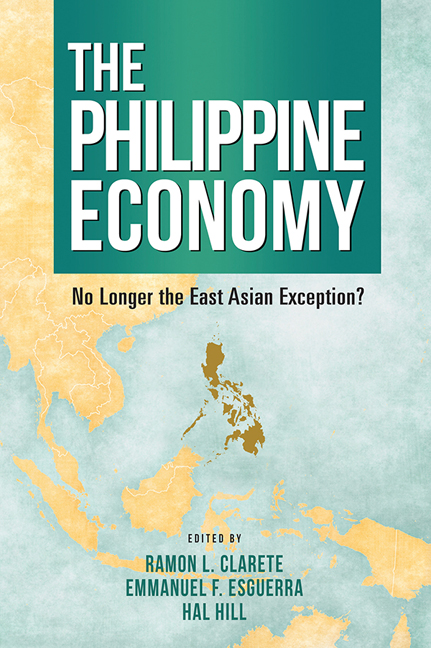Book contents
- Frontmatter
- Contents
- List of Figures
- List of Tables
- Foreword by Arsenio M. Balisacan
- Preface
- About the Contributors
- 1 The Philippine Economy: An Overview
- 2 Economic Growth and Poverty Reduction
- 3 Infrastructure and Urbanization
- 4 Education and Training
- 5 Universal Health Coverage, Health Security and Resilient Health Systems
- 6 Environmental Resources, Shocks and National Well-Being
- 7 Energy: Power Security and Competitiveness
- 8 Development Finance
- 9 Governance and Institutions
- Index
6 - Environmental Resources, Shocks and National Well-Being
Published online by Cambridge University Press: 12 February 2019
- Frontmatter
- Contents
- List of Figures
- List of Tables
- Foreword by Arsenio M. Balisacan
- Preface
- About the Contributors
- 1 The Philippine Economy: An Overview
- 2 Economic Growth and Poverty Reduction
- 3 Infrastructure and Urbanization
- 4 Education and Training
- 5 Universal Health Coverage, Health Security and Resilient Health Systems
- 6 Environmental Resources, Shocks and National Well-Being
- 7 Energy: Power Security and Competitiveness
- 8 Development Finance
- 9 Governance and Institutions
- Index
Summary
This chapter deals with promoting the common good through better energy, resource and environmental policies as well as improved management of natural disaster risks, including climate change. Increasing gross domestic product (GDP) will be insufficient to meet the aspirations of the Philippine people for higher levels of living, inasmuch as GDP does not measure welfare. Largely because of the omission of these elements, we begin with a discussion of green accounting — the method of extending national income accounting to include the degradation of the environment and the depletion of natural resources.
As we discuss in the second part, comprehensive national income accounting can be further extended to include natural disasters and other shocks to the ecological–economic system. Even policy distortions can be accounted for by including them as constraints to the system. Thus, environmental resource conservation, disaster preparedness and policy reform all become potential sources of welfare growth. The later section deals with the mission of sustainable development, particularly how the Sustainable Development Goals (SDGs) relate to the mission of improving the welfare of Filipinos.
Increasing Levels of Living in the Face of Environmental Degradation and Resource Depletion
Stewardship of natural resources and the environment should not be treated as a separate objective from management of the economy (World Commission on Environment and Development 1987). The fundamental premise of sustainable income and green accounting, which have a long history in the Philippines and other countries, is that nature and the economy are part of the same system (the environomy) as shown in Figure 6.1. And one system requires one unifying measure of performance.
To convert the most common indicator of the size of an economy, GDP, into a measure of national well-being, several adjustments must be made. It is well known that GDP overestimates public welfare by failing to deduct depreciation — that portion of investment that simply replaces capital which has worn out or become obsolete. Deducting capital depreciation from GDP yields net domestic product (NDP). And since income is a better measure of welfare than production, we need to subtract the income earned in the Philippines by foreigners, add income earned by Philippine citizens abroad, and add remittances to the Philippines by non-citizens.
- Type
- Chapter
- Information
- The Philippine EconomyNo Longer The East Asian Exception?, pp. 231 - 268Publisher: ISEAS–Yusof Ishak InstitutePrint publication year: 2018

